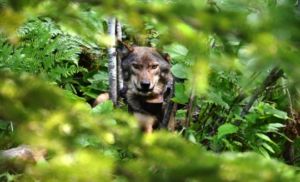MN Wolf Population Way Up But Court Still Bans State Management
The number of wolves in Minnesota soared last year, confirming the predator’s comeback as one of the Endangered Species List’s success stories. The wolf population leaped forward 25 percent thanks to a corresponding increase in the whitetail deer herd, according to the Duluth News Tribune.
But to many environmentalists, success means keeping wolves on the ESL, no matter what the science shows.
The DNR said its annual survey showed an estimated 2,856 wolves spread among 500 packs, up from 2,278 wolves in 438 packs in the 2015-2016 survey.
Wolf numbers had remained flat or declined some for several years before this year’s jump.
DNR officials said the wolf numbers are up because there are more deer in northern Minnesota for them to eat. Higher deer densities after three mild winters allow for more wolves, biologists said. Deer numbers in the wolf range are up about 22 percent over last year.
The latest count attests to what many northern Minnesota residents and DNR wildlife experts have believed for a long time. The wolf population has recovered to the point where it can support an annual hunting and trapping season.
“That first year we had a season, not only did we take more than 400 wolves through the public season, but there was also another 300 wolves taken (by federal trappers) for depredation control” at farms, Erb said. “Those two combined clearly did impact the population at that point. But all it really did was drive the (wolf) population down to what the deer-carrying capacity was at.”
Although other factors such as competition between packs, disease and run-ins with cars and people all impact wolf numbers, the number of prey typically determines the carrying capacity for wolves, Erb said.
But don’t hold your breath. The federal courts, rather than wildlife biologists, are calling the shots. Despite three successful seasons of state wolf management through hunting and trapping, a federal judge in Washington, D.C. put the animal back under federal protection in late 2014 in Minnesota, Michigan and Wisconsin.
The DNR’s goal for wolf management, as outlined in the state’s wolf management plan, is to ensure the long-term survival of wolves in Minnesota while addressing wolf-human conflicts, especially wolves attacking livestock and pets.
Legislation to return wolf management to the states has been introduced in Congress, but a federal appeals court recently upheld the lower court’s hunting and trapping ban. All of which begs the question of whether there’s a magic number of wolves that would ever satisfy the environmentalists or the court.
Collette Adkins, senior attorney for the Center for Biological Diversity, said the population jump is good news. She said the unusually large single-year increase shows the impact three hunting and trapping seasons had on wolves. She also noted that the population still hasn’t returned to levels before the state hunting and trapping seasons were held.
“Once again protected under the federal Endangered Species Act, Minnesota’s wolves are rebounding from state-sanctioned hunting seasons,” Adkins said. “To allow further recovery, now we need to defeat Congressional efforts that would strip our state’s wolves of the very safeguards that allowed them to bounce back.”
The DNR, hunting and farmer groups disagree, saying wolves have fully recovered from the brink of extinction and can be culled in limited hunting and trapping seasons each year.
Meantime, farmers and cattle ranchers remain effectively defenseless in protecting their herds, even pets against wolf depredation. Farmer Miles Kuschel described what happened when a pack of six wolves targeted his cattle a couple years ago.
“They came, they killed and they left, but they’re still around. They just move on to the neighbor’s place,” said Kuschel, president of the Cass County Chapter of the Farm Bureau.
